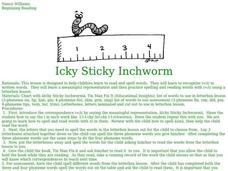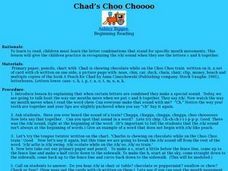Curated OER
Achoo!
Focus in on the digraph ch. Young readers will hear the sound, print the letters, and read A Peach for Chad. Can your youngsters think of any more words that use the target sound?
Curated OER
Icky Fingers
Which i sound is used in the word icky? Kindergarteners and first graders listen to the short /i/ sound. They practice shaking their fingers to indicate icky when they hear the target sound. Then they practice reading a poster with the...
Curated OER
Beginning and Ending Sounds - Lesson 1 of 2
Stamp, slap, and clap! Emergent readers demonstrate their awareness of the initial, medial vowel, and final sounds in spoken, short vowel, single-syllable words with a stamp/slap/clap activity. After identifying the letters and sounds of...
Curated OER
Mmm, Mmm ... Good!
Help primary students learn the /m/ sound. As they listen as the teacher introduces the "Secret Code" of language they will practice the /m/ sound by rubbing their tummies as if eating something good. They also practice hearing and...
Curated OER
Phonics: Decode and Write Words with Blends
Kids see, say, then count the phonemes they hear in a series of simple words. They practice counting phonemes with the teacher, then sound out the same word on their own. As they count each phoneme they write it down on their paper. A...
Curated OER
Decode and Write Words with More Than One Syllable
Practice sounding out multi-syllable words with this scaffolded lesson. Learners decode words by segmenting them into phonemes and combining the sounds. Your lines are in bold here, but you can easily use this simply as an outline...
Curated OER
OW! I stubbed by toe
Drill and practice the /ow/ sound! Kids practice recognizing pictures that begin with the ou=/ou/ correspondence. They experience a letterbox lesson to help implement this task before them as well as reading the story, The Napping House,...
Curated OER
Blast-Off to Blending
Practice working with different phonemes in consonants and vowels. Sounds are written on squares that get put on a rocket to "blast off" and meet other sounds. The teacher first models blending, then reads the new words. Young readers...
Curated OER
Sssssssss
Students experience the strategy of phoneme recognition to recognize /s/ in spoken words, including plurals, and in writing. They encounter the book Summer Fun by Lucy Lawrence and the tongue twister "Miss Sam saw a sneaky slimy snake in...
Curated OER
Letter Sound Fluency
How fast can you go? Test scholars' letter sound recognition with a timed game. Using letter cards of all the letters you've learned so far, learners take turns flipping cards and correctly saying the letter sound. Model this first,...
Curated OER
Icky Insect Is In Icky Sticky Ink
Practice the strategy of letter-sound correspondence when identifying the short vowel /i/ sound in written and spoken words. The teacher recites the tongue twister "Icky insect is in icky sticky ink," while listeners repeat. Letter boxes...
Curated OER
Sight Words
Are you working on sight words in your kindergarten class? Send a sight word template home with your kindergarteners. After cutting apart the flash cards, class members practice reading twelve common sight words.
Curated OER
Icky Sticky Inchworm
Use the meaningful example "Icky Sticky Inchworm" to demonstrate the /i/ sound. Then have learners take out letter boxes and spell simple words like six, lip, him, pin, slim, grin, etc.
Curated OER
Chad's Choo Choooo
Choo, choo! Do your youngsters like trains? After studying the target sound, have your learners read A Peach for Chad. Do a class read and an independent read to increase fluency. At the lesson's close, consider creating a ch train...
Curated OER
Shhh! Be Quiet
Teach the digraph sh with your learners. First, model the sound the digraph makes. Then, have learners spell a variety of words that use the target sound. Finally, read Shoe Man, where learners can hear the words in context.
Curated OER
Cheese Please
Do you like cheese? What sound does the word start with? Learn all about the /ch/ sound and what other words make the same sound.
Curated OER
Final Consonant Sounds: Review - ft, ld, lt, mp, nd
These are challenging phonics review sheets. On the first page, learners match the end sounds to the pictures and write a rhyming word for each word. For the second page, pupils choose an end sound to complete a series of incomplete...
Curated OER
Introduce Onset-Rime Blending
Mico (or your favorite puppet) helps emergent readers recognize words from segmented phonemes. Explain to learners that he struggles with pronouncing words and needs their help. Model how Mico segments sounds in single-syllable words....
Curated OER
Reintroduce /a/
What does the letter a sound like? Scholars practice with letter sound correspondence by honing their pronunciation of the /aaa/ sound. Use these helpful tips to explain how to make this sound if needed. Then, they brainstorm...
Curated OER
Phase 5
Have your class practice reading and spelling common sounds. Learners read a list of sounds and identify words that have it. Here you will find just a quick review of this topic. The presentation could be enhanced for a richer experience.
Curated OER
Odd One Out
Practice lowercase letters i-n with this initial sounds worksheet. There is a row of three objects for each of these letters, and scholars examine them to determine which does not begin with the letter sound. This would work best with...
Little Book Lane
"Ch" Words
What do chug and chain have in common? The consonant digraph ch of course. Hold onto your hats – here is a packet of worksheets with enough practice activities to fill a short unit. It contains two lists of ch words, three practice...
Core Knowledge Foundation
Kindergarten Skills Unit 6
Throughout 15 lessons, scholars explore four and five-sound and rhyming words, closely examining initial and final consonant sounds, and begin reading the text independently. Each lesson follows a similar routine; an introduction to...
Core Knowledge Foundation
Kindergarten Skills Unit 2
Kindergarteners practice prewriting skills in a 10-day unit. Young scholars blend sounds and syllables, build shapes with playdough, write shapes on paper, and trace their names.

























